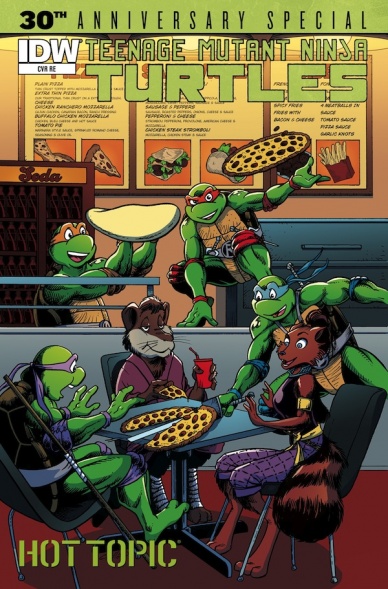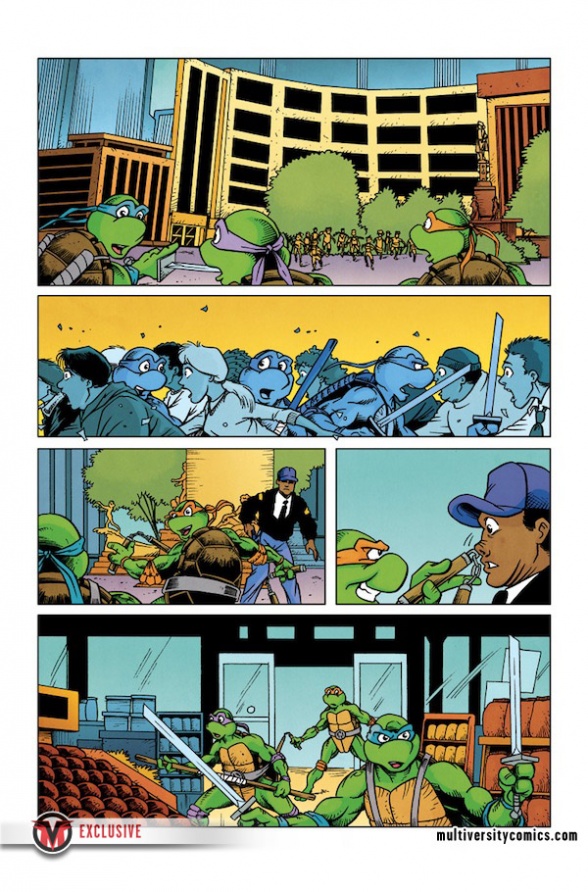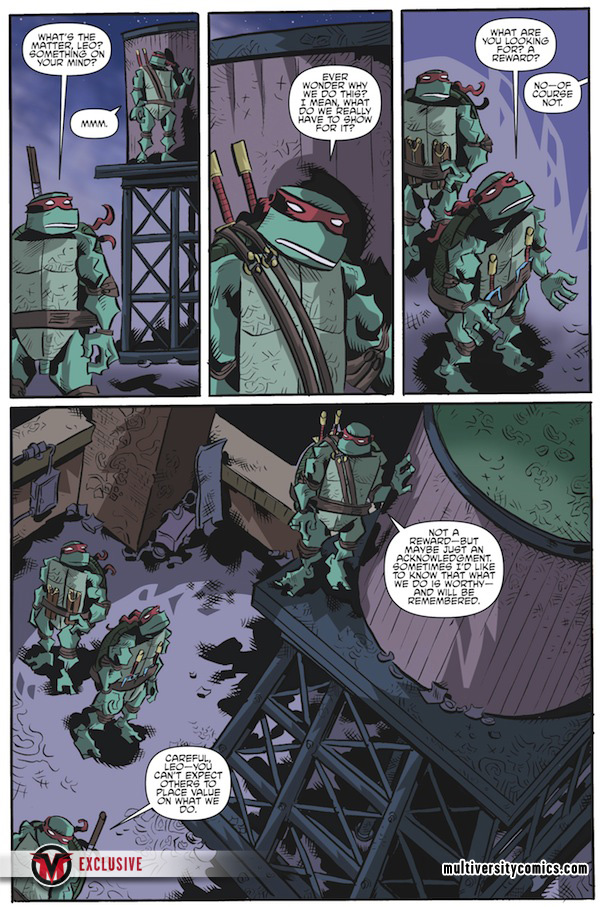
“Teenage Mutant Ninja Turtles” turns 30 this month, making it officially older than many of our Multiversity staff. To celebrate, this week we are featuring a lot of Turtles content, including interviews from many of the creators who have made the Turtles what they are over the past 30 years of comics, all of whom are featured in the brand new “Teenage Mutant Ninja Turtles 30th Anniversary Special,” on sale on Wednesday from IDW. Today, we talk to Dean Clarrain, real name Stephen Murphy, and Chris Allan, who wrote and drew the lion’s share of the “Teenage Mutant Ninja Turtles Adventures” series, published by Archie from 1988-1995. The series was connected, in look and tone, to the animated series that many of us grew up watching. In addition to talking with Dean and Chris, we also have two exclusive pages from Chris from the new “Adventures”-era story in the “30th Anniversary Special.”

Like a lot of folks my age, I never had the chance to get my hands on the original TMNT comics, so Archie’s “Teenage Mutant Ninja Turtles Adventures” were the Turtles as far as I was concerned. The series started with a mini-series that adapted the first serial from the animated show, and then became an ongoing… an ongoing that continued to adapt the show’s episodes. But after a few issues, you came aboard and started doing original content for the series.
How did you first get involved with the Turtles, Steve? Were you part of the decision making process to break Adventures away from the animated series and off into its own thing?
Dean Clarrain, aka Stephen Murphy: It was Mirage Studios artist Ryan Brown who suggested I try my hand writing for children by scripting TMNT Adventures #5 over his original plot which, in a sense, I had to do seeing as how at that time I’d never watched an episode of the cartoon. Ryan deserves a lot of credit for the success of the series via his plots and/or our co-plots.
One thing I enjoyed about your era is how you pulled in a lot of the mutants from the Playmates toy line, with Man Ray / Ray Fillet being a personal fave. Were you given any direction or product notes / information about those characters before introducing them, or were they basically blank slates?
DC: Actually, we didn’t work from the Playmates toys, so much as we worked from our ideas and designs for submitted action figure concepts, of whom Man Ray was the first. That was our primary goal in terms of character inclusion, followed later by sprinkling the series with existing action figure characters, for whom we created original back stories whenever possible.
Chris, you joined Steve on “Adventures” a few years into his run, but ended up drawing most of the series from there forward. How did you come to work on the book, and how much did you know about the Turtles going in?
Chris Allan: I was working on staff at Archie Comics (my first job out of college) and I was given an opportunity to do a fill-in issue. I had to work my regular full-time job then go home and draw the art for the comic. It was grueling, but I was determined to deliver it on time and as good as I could make it. I guess people liked it because when the regular artist, wanted to move on to bigger and better things, I was offered the book. Of course, I jumped on it.
What was the collaborative process like between you guys, and how did it evolve over the course of your time on the book?
CA: Originally, it was pretty tight since, of course, Murph had no idea who I was. I would receive fully dialogued scripts spelling out the specific action on each page. Over time, as Murph and I got more comfortable (and, I suspect, as Murph’s workload increased), I would receive looser scripts, sometimes offering just the barest description of what would be happening. I remember one script where I was just told “fight for the following three pages!” I really enjoyed working this way and the work became much more collaborative. Murph always ran the story. It was always his initial vision, but he was always open to my suggestions. It remains one of the best jobs I ever had.
Continued belowDC: If I remember correctly we either phoned or faxed each other plot ideas and then banged the ideas around until we were both happy.

Which Turtle (or supporting character) did you identify with the most, and why?
DC: In terms of Turtles, I honestly identified with them all, I guess perhaps because I threw different aspects of myself into each one of them. Raph was my rebellious side, Leo my managerial, Donnie my scientific and Mikie the little kid that lived inside me that never grew up. Jagwar and Ninjara remain my favorite secondary characters, he for his devotion to the earth, she for her survival instincts and her overall coolness.
CA: I always felt the whole group, Splinter included, formed a complete consciousness. Each character was a different aspect of a full personality, so depending on my frame of mind I felt closer to each one in turn. Having said that, Raph was the coolest. And I don’t personally identify with her, but Ninjara was always my favorite.
“Adventures” distinguished itself by addressing social issues like global warming, the consequential effects of nuclear energy, and illegal poaching… topics which, as a kid, I’d never given much thought to before then. What was the reaction like to those storylines, both from readers and the publisher?
DC: We never received a negative letter from kids or parents, always just the opposite, which was infinitely gratifying. There were negative mumblings on rare occasions from management at Archie but overall they were just as supportive as Eastman and Laird, which is to say they were close to mute on the subject.
CA: I was a bit removed from reactions from readers at the time. This was way before social media, so a fan would have to have a bit more initiative to actually write a letter and even then it went to the Mirage Studios in Massachusetts while I was based in New York. I would hear mostly positive reviews.
Speaking of the publisher, what kind of editorial influence did Archie have on Adventures? Did their handling of the property change over the wax and wane of the Turtles popularity?
CA: Archie had little to no influence on what we did, which is part of what made it such a great job. Peter and Kevin could have exercised editorial control, but they were focused on the main book and the toy line and the movies and who knows what else. We were doing the kiddie book. They didn’t want to be bothered with us. Subsequently, Murph and I had free reign to do pretty much whatever we wanted, which over time gave the book a pretty free-wheeling reputation, not undeservedly. I suspect that was as much a reason as waning initial popularity that Archie dumped the book. At the time, Archie was a deeply risk-averse company that would never release properties like they have recently. It’s turning into a very fun publisher.
DC: Archie had absolutely no editorial influence on the title. The only time they pitched a fit was when we had Raphael beating the crap out of Hitler’s brain: for some reason they thought I was being anti-Semitic when in fact I was being just the opposite. The matter went so far as to reach the office of Mirage’s law firm, where the Jewish member of the partnership reviewed that particular issue and deemed it anti-Nazi! In the end, we changed nothing.
CA: The Hitler’s brain story often comes up as a high point of the weirdness we were creating and a source of personal pride for me. Knowing that it annoyed so many people at the time only makes it better!
After your time on “Adventures” ended, you partnered again on several issues of Mirage’s “Tales of the TMNT.” And Steve, you went on to write for the 2003 TMNT animated series. How was your approach different on those projects compared to what you had done at Archie?
DC: Quite different. On the animated show you were given a brief plot that you had to follow. On Archie we were free to do as we pleased. In the case of Mirage’s Tales, writers submitted plots to Peter Laird for approval, rejection or tweaking.
CA: Working again with Murph on “Tales” was great! It was just like going back to the good ol’ days. Same loose, collaborative approach that I always enjoyed. Murph is just a joy to work with. I had missed it.
What was it like stepping back into the “Adventures” universe for the anniversary special?
DC: Literally like stepping back into a pair of well-worn shoes that you’d thought lost and which you were now given back, however briefly. My greatest joy on the project aside from having Bobby [Curnow] as an editor was in seeing Chris Allan imbue each drawing of each turtle in their Adventures personas – their expressions and body language were just as they were all those years ago. All the warmth and attraction that I used to feel for the characters returned almost in an instant, and I remain thankful for the opportunity to write them for the anniversary book for allowing me to experience those feelings again.
CA: Since it was a new publisher, it was a little different than it had been. Murph and I now had an editor through whom our work was funneled. It was definitely a more structured environment. It wasn’t worse, or better, but it was different. Bobby Curnow is terrific to work with!
What’s your relationship to the Turtles today? Do you follow the IDW comics, or watch the current show?
CA: I’m afraid I don’t follow the current incarnations of the TMNT. My cartoon preference is more Adventure Time and I don’t spend much time with the comics.
DC: The relationship is a funny one. My daughter and I have been telling each other original Turtle stories for the past three years (she’s now 9), so for me, they’ve never gone away. She’s also been drawing her own Turtles comic book stories and, naturally, has a large box of loose TMNT action figures that we used to play together with quite a bit until this past year. She watches the new show on streaming and on the occasion that I’ve looked over her shoulder I’ve enjoyed what I’ve seen, especially the writing, which is heartfelt and clever. I’m embarrassed to say that I don’t read the comics but then again I don’t read many comics at all these days aside from modern collections of comics from the 30s through the 70s.
Where do you see the Turtles 30 years from today?
DC: Still owned by Viacom, which by some point in the near future will also lock down movie rights and expand the TMNT universe in their own making between two or three reboots of the entire franchise. I honestly don’t think floppy monthly comic books will be around in 30 years, although comic book style stories will flourish in electronic media form.
CA: Oh, they’ll be around. Probably into the fourth reboot franchise. Green Hornet, Lone Ranger and John Carter had major movies recently, so these things never die.






